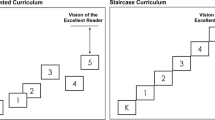Abstract
Technology is one of eight learning areas of the New Zealand national curriculum. It aims to develop a broad technological literacy through students participating in programmes in which the practice of technological development is experienced, as is knowledge informing practice, and students gain an understanding of technology as a domain in its own right. In New Zealand children begin school at 5 years of age and this paper describes a classroom research project during which these students design and then construct a photo frame. The inducement for this development arose from students needing to safely transport home and then display a class photograph. This provided the opportunity for developing technological knowledge and skills within a real and relevant context—two key drivers when working with young students (Ministry of Education 2007) [MoE]. The results of this project suggest that teaching technology to five-year-old students is achievable and a valuable addition to other learning opportunities provided in the new entrant classroom. Strategies are suggested that will enable students to successfully achieve their goals whilst gaining a simple understanding of the technological process. By making good use of these it is possible to create a worthwhile and imaginatively challenging activity that reflects the essence of the technology education curriculum.





Similar content being viewed by others
References
Baynes, K. (1992). The basis of designerly thinking in young students. In A. Dyson (Ed.), Looking, making and learning: Art and design in the primary school (pp. 70–85). London: Kogan Page.
Bottrill, P. (1995). Designing and learning in the elementary school. International Technology Association.
Brown, J., Collins, A., & Duguid, P. (1998). Situated cognition and the culture of learning. Educational Researcher, 18(1), 32–42.
Cohen, L., Manion, L., & Morrison, K. (2000). Research methods in education. London: Routledge.
Coghill, V. (1989). Making and playing, the other basic skills: Design education for the early years. In A. Dyson (Ed.), Looking, making and learning: Art and design in the primary school (pp. 56–60). London: Kogan Page.
Constable, H. (1994). A study of aspects of design and technology capability at key stage 1 and 2. IDATER, 94, 9–14.
Egan, B. A. (1995). How do students perceive the art of drawing? Some initial observations of students in an infant school. Design and Technology Education Research, 95, 10–14.
Fleer, M. (2000). Working technologically: Investigations into how young students design and make during technology education. Canberra: University of Canberra.
Gentle, K. (1989). Direct sensory experience as the source of nourishment for ideas, concepts and imagination. In A. Dyson (Ed.), Looking, making and learning: Art and design in the primary school (pp. 86–100). London: Kogan Page.
Golomb, C. (2004). The child’s creation of a pictorial world. Mahwah, N.J.: Erlbaum Associates.
Harlow, M. A., Jones, A. T., Milne, R. L., Moreland, J. P., & Forret, A. M. (2003). Progression in learning technology: Report of the NEMP probe study in technology 1996 and 2000. (Report to Ministry of Education) Hamilton, University of Waikato, pp. 1–125.
Hope, G. (2008). Thinking and learning through drawing in primary classrooms. Los Angeles: Sage.
Jolley, R. P. (2010). Children and pictures: Drawing and understanding. Chichester, England: John Wiley.
Lambert, B. (2000). Problem solving in the first years at school. Australian Journal of Early Childhood, 25(3), 32–38.
Lave, J., & Wenger, E. (1991). Situated learning: Legitimate peripheral participation. Cambridge, England: Cambridge University Press.
Medway, P. (1992). Constructions of technology: Reflections on a new subject. In J. Beynon & H. Mackay (Ed.), Technological literacy and the curriculum (pp. 65–80).
Milne, R. L. (2003). Technology education in the new entrant classroom. Unpublished masters thesis, University of Waikato.
Milne, R. L., & Edwards, R. (2011). Young children’s views of the technology process: An exploratory study. International Journal of Technology and Design Education,1–11. doi:10.1007/s10798-011-9169-1.
Ministry of Education. (1986). Forms 1–4 workshop craft syllabus for schools. Wellington: Learning Media.
Ministry of Education. (1995). Technology in the New Zealand curriculum. Wellington: Learning Media.
Ministry of Education. (1996). Te Whariki: Early childhood curriculum. Wellington: Learning Media.
Ministry of Education. (2007). The New Zealand curriculum. Wellington: Learning Media.
Moreland, J. P., Jones, A., & Chambers, M. (2001). Enhancing student learning in technology through enhancing teacher formative interactions. SET: Research Information for Teachers, 3, 16–19.
Punch, K. F. (2009). Introduction to research methods in education. London: SAGE.
Rogers, G., & Wallace, J. (2000). The wheels of the bus: Students designing in an early years’ classroom. Research in Science and Technological Education, 18(1), 127–136.
Rogoff, B. (1991). The cultural nature of human development. New York, Oxford University Press.
Siegler, R. S. (1996). The five to seven year shift. Chicago: University of Chicago.
Siegler, R. S., & Alibali, M. W. (2005). Children’s thinking (4th ed.). New Jersey: Prentice-Hall Inc.
Stake, R. E. (1995). The art of case study research. Thousand Oaks: Sage.
Thomas, G. V., & Silk, A. M. J. (1990). An introduction to the psychology of students’ drawings. New York: New York University.
Acknowledgments
I would like to acknowledge the teacher and students involved in this project during the collection of the original data and thank them for their interest, enthusiasm and laughter.
Author information
Authors and Affiliations
Corresponding author
Rights and permissions
About this article
Cite this article
Milne, L. Nurturing the designerly thinking and design capabilities of five-year-olds: technology in the new entrant classroom. Int J Technol Des Educ 23, 349–360 (2013). https://doi.org/10.1007/s10798-011-9182-4
Published:
Issue Date:
DOI: https://doi.org/10.1007/s10798-011-9182-4




